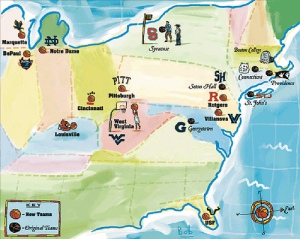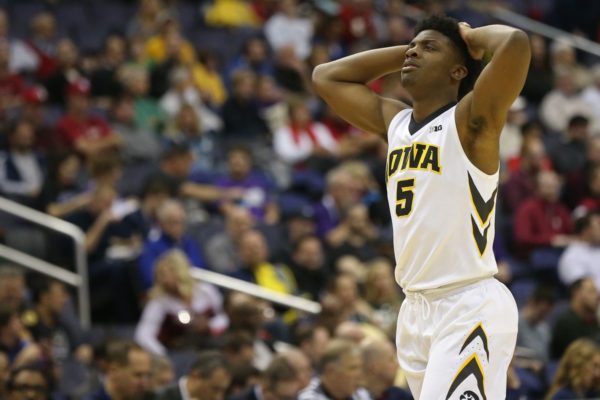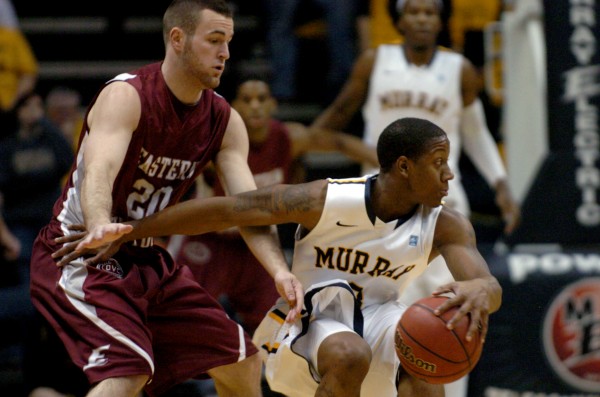Posted by rtmsf on October 27th, 2008
We’re barely over a week into practice and there’s already been some talk that this year’s version of the Big East, with as many as four legitimate F4 contenders (UConn, Pitt, Louisville & Notre Dame) and another five or six legitimate NCAA Tournament teams, could be the deepest, most competitive conference of all-time. When put in those terms, it’s difficult to disagree… but you know us, we don’t take kindly to sweeping claims of superiority without some measurable statistical basis to back it up.

(photo credit: Bob Eckstein)
The problem is figuring out how to measure such a thing. Take last year’s Pac-10, for example. The conference was widely considered by pundits to be the strongest, deepest conference in America. Computer ratings tended to agree. At various points during the season, as many as eight of its ten schools were touted as NCAA-caliber teams. Six ultimately were invited to the NCAA Tournament, but only three of those made it to the Sweet Sixteen, with UCLA the sole conference representative in the Final Four. Was the Pac-10 stronger than the Big East, who had six teams ranked in the final AP poll last year (vs. three for the Pac-10) and had two more teams invited to the Big Dance but only found itself with a pair standing on the second weekend (and zero in the F4)? Or was the Pac-10 superior to the Big 12, who had the strongest NCAA showing of the major conferences with a 6-0 first round ultimately resulting in Kansas cutting down the nets? It’s hard to say, because depending on how you set the parameters, you can make fair and defensible arguments for the strength of multiple conferences in any given year (our friends dealing with the BCS go through this every year).
Just thinking back to last season, we could break it down this way. AP poll? Big East. NCAA Tournament success? Big 12. Computer rankings? Pac-10. Pundits? Take your pick, but leaning Pac-10. Choosing which source to buy into is based on personal taste, but for the sake of this post, we’ll admit that there is no perfect measurement and focus exclusively on Jeff Sagarin’s computer ratings. Using his data, we like that we can take stock year over year in relative terms.

 (photo credit: sportsbubbler.com)
(photo credit: sportsbubbler.com)
So here’s our question: how good does the Big East need to be from top-to-bottom this year to be statistically considered the top conference of the last decade (Sagarin’s archive only goes back to the 1998-99 season – we requested data back to 1984-85, to no avail)? For the sake of comparison, here are the top ten conferences by Sagarin’s computer ratings of the last ten years.

As you can see, the 2008 version of the Big East wasn’t bad from top-to-bottom, but it was still a good distance away from the top ten conferences of the last decade. The problem is that when people talk about how strong conferences are, are they really talking about team #10 or team #12 or team #16 in the cellar? Of course not – they’re really talking about the NCAA-caliber teams, i.e., the top half of the conference. So how does this list change if we only consider the top half of the major conferences of the last ten years (also represented graphically)?


It’s interesting to imagine if the Big East were still an eight-team conference like the old days, as last year’s top half alone would have rated the league as the second-best conference of the last decade (2004 ACC at 87.31 would still be #1). As it stands, though, the Big East’s mammoth size probably ensures that from a statistical standpoint (Law of Large Numbers, much?), it will never be able to have enough great teams to overcome what some of the smaller conferences have been able to do.
Nothing is conclusive here, but we feel safe in saying that the 2008-09 Big East is unlikely to rise to the top of either of these lists, but it wouldn’t shock us if the conference ended up in the top ten (esp. the top-half list). Notwithstanding where the conference Sagarin ratings finish, there shouldn’t be any question using the eyes and ears test that the Big East will be the most competitive and interesting conference in America this season.
| rtc analysis
| Tagged: acc, ap poll, best conferences, big 12, big east, big ten, connecticut, kansas, louisville, ncaa tournament, notre dame, pac-10, pittsburgh, sagarin ratings, sec, ucla
Share this story

















































